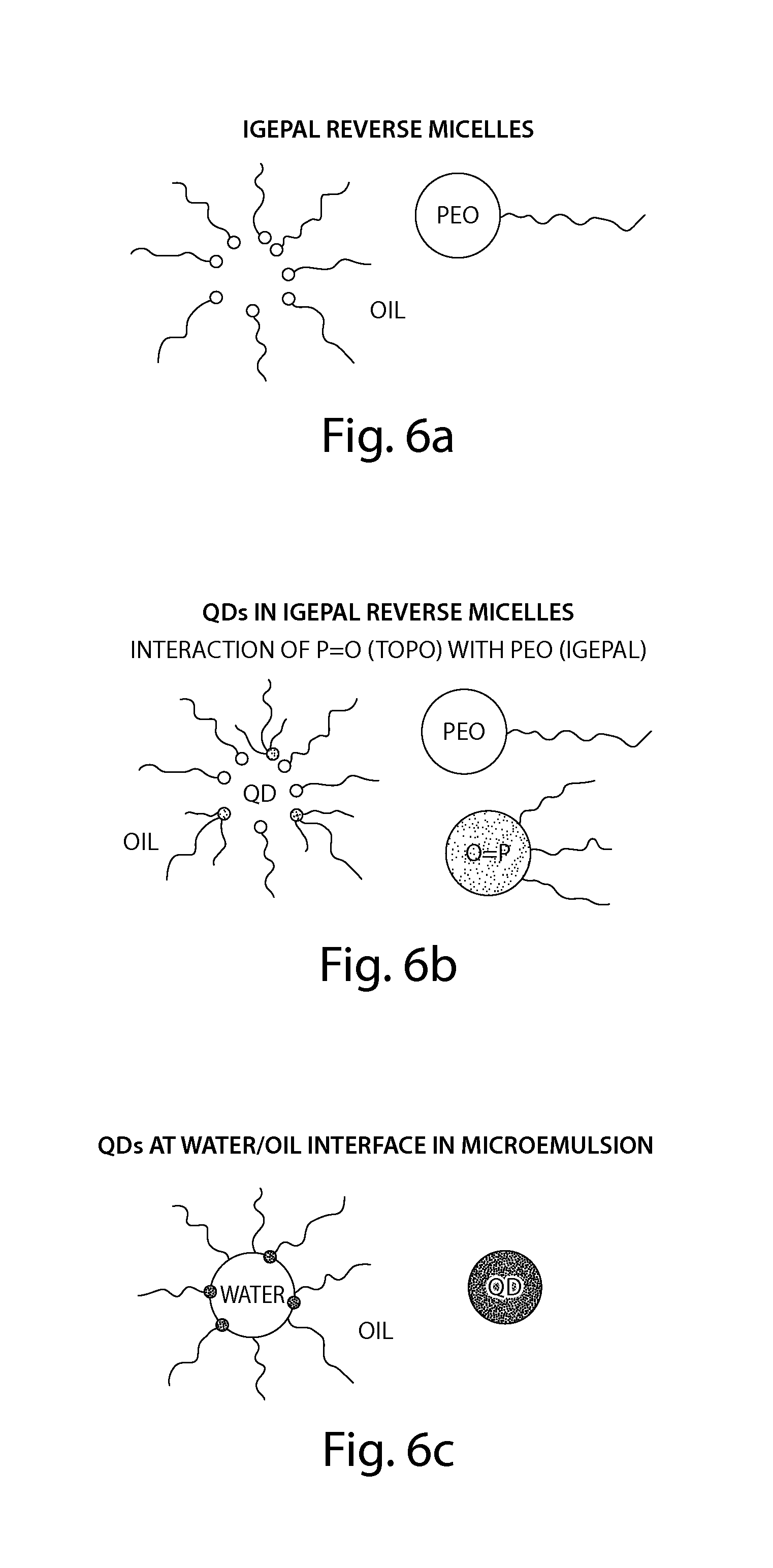Coated water-soluble nanoparticles comprising semiconductor core and silica coating
a technology of water-soluble nanoparticles and semiconductor cores, applied in the field of nanoparticles, can solve the problems of not photo-stable and toxic, organically coated quantum dots have been shown to be unstable and exhibit deteriorating photo-luminescent properties, and the procedure is complicated and time-consuming
- Summary
- Abstract
- Description
- Claims
- Application Information
AI Technical Summary
Benefits of technology
Problems solved by technology
Method used
Image
Examples
example 1
Preparation of Silica-Coated ZnS-capped CdSe Nanocrystals (CdSe / ZnS / SiO2) in Reverse Microemulsion (Aqueous in Non-aqueous Emulsion)
[0071]CdSe / ZnS semiconductor nanocrystals with excess TOPO without any surface modification were prepared according to literature procedures (Hines et al., “Synthesis and Characterization of Strongly Luminescing ZnS-Capped CdSe Nanocrystals” J. Phys. Chem. 100, 468-471, 1996. Dabbousi et al., “(CdSe)ZnS Core-Shell Quantum Dots: Synthesis and Characterization of a Size Series of Highly Luminescent Nanocrystallites” J. Phys. Chem. B 101, 9463-9475, 1997.). The particles had luminescence quantum yields of 10-25% and emission at 625 nm (FWHM=30 nm). The particles were precipitated once from methanol to remove excess TOPO and trioctylphosphine oxide (TOP). Inverse micelles were prepared using a non-ionic surfactant such as Igepal CO-520 and cyclohexane as solvent.
[0072]FIGS. 6 and 7 depict the schemes of the transformation of hydrophobic semiconductor nanocr...
example 2
TEM Characterization of Silica-Coated ZnS-capped CdSe Nanocrystals (CdSe / ZnS / SiO2) in Reverse Microemulsion
[0073]Electron microscopy revealed that the majority (>90%) of nanocrystals are encapsulated as single particles within a silica shell (FIG. 8). The average total diameter of nanocrystal / Silica is ˜22 nm. FIG. 9 shows the encapsulation of nanocrystals within ca. 100 nm silica in the reverse microemulsion. Varying the amount of water and ammonia in the microemulsion also affects the shell thickness, since this alters the aqueous domain size. The silica shell thickness can be increased by increasing the TEOS concentration as shown in FIG. 10. The higher the concentration of TEOS the larger is the silica diameter. Increase in the size of silica lowers the emission intensity and QY. The total diameter of coated nanocrystals affect the QY relative to the uncoated nanocrystals, which is also shown in FIG. 10.
example 3
Emission Characteristics of Silica-Coated ZnS-capped CdSe Nanocrystals (CdSe / ZnS / SiO2) in Water
[0074]Silica-coated nanocrystals in the microemulsion were centrifuged at 18000 rpm for 30 minutes and the pellet was washed with cyclohexane twice and dispersed in an alkaline aqueous solution of pH 8-9. The silica-coated nanocrystals in water were characterized by UV-visible absorption spectroscopy and fluorescence spectroscopy. FIG. 11 shows the absorption and fluorescence spectra of the CdSe nanocrystals before and after silica coating. UV-visible and photoluminescence spectra show that there is a 5 nm red-shift for CdSe / ZnS / SiO2 in water, in comparison to the CdSe / ZnS nanocrystals in the parent solution, butanol. Silica-coated semiconductor nanocrystals in water showed remarkable colloidal stability over a period of several months.
[0075]Silica-coated nanocrystals showed remarkable photostability. The nanocrystals in water and in butanol were exposed to UV irradiation (335 nm cut-off f...
PUM
| Property | Measurement | Unit |
|---|---|---|
| diameter | aaaaa | aaaaa |
| mean diameter | aaaaa | aaaaa |
| size | aaaaa | aaaaa |
Abstract
Description
Claims
Application Information
 Login to View More
Login to View More - R&D
- Intellectual Property
- Life Sciences
- Materials
- Tech Scout
- Unparalleled Data Quality
- Higher Quality Content
- 60% Fewer Hallucinations
Browse by: Latest US Patents, China's latest patents, Technical Efficacy Thesaurus, Application Domain, Technology Topic, Popular Technical Reports.
© 2025 PatSnap. All rights reserved.Legal|Privacy policy|Modern Slavery Act Transparency Statement|Sitemap|About US| Contact US: help@patsnap.com



